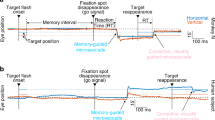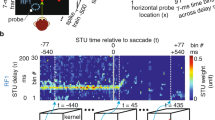Abstract
When viewing a stationary object, we unconsciously make small, involuntary eye movements or ‘microsaccades’. If displacements of the retinal image are prevented, the image quickly fades from perception. To understand how microsaccades sustain perception, we studied their relationship to the firing of cells in primary visual cortex (V1). We tracked eye movements and recorded from V1 cells as macaque monkeys fixated. When an optimally oriented line was centered over a cell's receptive field, activity increased after microsaccades. Moreover, microsaccades were better correlated with bursts of spikes than with either single spikes or instantaneous firing rate. These findings may help explain maintenance of perception during normal visual fixation.
This is a preview of subscription content, access via your institution
Access options
Subscribe to this journal
Receive 12 print issues and online access
$209.00 per year
only $17.42 per issue
Buy this article
- Purchase on Springer Link
- Instant access to full article PDF
Prices may be subject to local taxes which are calculated during checkout









Similar content being viewed by others
References
Livingstone, M. S., Freeman, D. C. & Hubel, D. H. Visual responses in V1 of freely viewing monkeys . Cold Spring Harb. Symp. Quant. Biol. 61, 27–37 (1996).
Bair, W. & O'Keefe, L. P. The influence of fixational eye movements on the response of neurons in area MT of the macaque. Vis. Neurosci. 15, 779–786 (1998).
Leopold, D. A. & Logothetis, N. K. Microsaccades differentially modulate neural activity in the striate and extrastriate visual cortex. Exp. Brain Res. 123, 341–345 (1998).
Bair, W., Koch, C., Newsome, W. & Britten, K. Power spectrum analysis of bursting cells in area MT in the behaving monkey. J. Neurosci. 14, 2870–2892 (1994).
Riggs, L. A. & Ratliff, F. The effects of counteracting the normal movements of the eye. J. Opt. Soc. Am. 42, 872–873 (1952).
Ditchburn, R. W. & Ginsborg, B. L. Vision with a stabilized retinal image. Nature 170, 36–37 (1952).
Hubel, D. Cortical unit responses to visual stimuli in non anesthetized cats. Am. J. Opthalmol. 46, 110–122 (1958).
Hubel, D. H. & Wiesel, T. N. Receptive fields of single neurones in the cat's striate cortex. J. Physiol. (Lond.) 148 , 574–591 (1959).
Coppola, D. & Purves, D. The extraordinarily rapid disappearance of entoptic images. Proc. Natl. Acad. Sci. USA 93, 8001–8004 (1996).
Gur, M., Beylin, A. & Snodderly, D. M. Response variability of neurons in primary visual cortex (V1) of Alert Monkeys. J. Neurosci. 17, 2914–2920 (1997).
Dodge, R. Visual perception during eye-movements. Psychol. Rev. 7, 454–465 (1900).
Wurtz, R. H. Visual cortex neurons: response to stimuli during rapid eye movements. Science 162, 1148–1150 ( 1968).
Wurtz, R. H. Comparison of effects of eye movements and stimulus movements on striate cortex neurons of the monkey. J. Neurophysiol. 32, 987–994 (1969).
Wurtz, R. H. Response of striate cortex neurons to stimuli during rapid eye movements in the monkey. J. Neurophysiol. 32, 975– 986 (1969).
Bridgeman, B., Hendry, D. & Stark, L. Failure to detect displacement of the visual world during saccadic eye movements. Vision Res. 15, 719–722 (1975).
Macknik, S. L., Fisher, B. D. & Bridgeman, B. Flicker distorts visual space constancy. Vision Res. 31, 2057–2064 (1991).
Gerrits, H. J. & Vendrik, A. J. The influence of stimulus movements on perception in parafoveal stabilized vision. Vision Res. 14, 175–180 (1974).
Sansbury, R. V., Skavenski, A. A., Haddad, G. M. & Steinman, R. M. Normal fixation of eccentric targets. J. Opt. Soc. Am. 63, 612–614 (1973).
Steinman, R. M., Haddad, G. M., Skavenski, A. A. & Wyman, D. Miniature eye movement. Science 181, 810 –819 (1973).
Day, E. C. Photoelectric currents in the eye of the fish. Am. J. Physiol. 38, 369–398 ( 1915).
Magleby, K. L. in Synaptic Function (eds. Edelman, G. M., Gall, W. E. & Cowan, W. M.) 21–56 (Wiley, New York, 1987).
Zucker, R. S. Short-term synaptic plasticity Annu. Rev. Neurosci. 12, 13–31 (1989).
Usrey, W. M., Reppas, J. B. & Reid, R. C. Paired-spike interactions and synaptic efficacy of retinal inputs to the thalamus. Nature 395, 384–387 (1998).
Albrecht, D. G., & Hamilton, D. B. Striate cortex of monkey and cat: contrast response function. J. Neurophysiol. 48, 217–237 ( 1982).
Albrecht, D. G., Visual cortex neurons in monkey and cat: effect of contrast on the spatial and temporal phase transfer functions.. Vis. Neurosci. 12, 1191–1210 (1995).
Gawne, T. J., Kjaer, T. W. & Richmond, B. J. . Latency: another potential code for feature binding in striate cortex.. J. Neurophysiol. 76, 1356–1360 (1996).
Judge, S. J., Chu, F. C. & Reid, R. C. . Implantation of magnetic search coils for measurement of eye position: an improved method. Vision Res. 20 , 535–538 (1980).
Acknowledgements
We thank Gail Robertson, David Freeman, Michael Lafratta and Frederic Russo for technical assistance and Margaret Livingstone, Clay Reid, Richard Born and Max Snodderly for reading the manuscript and making comments. We also thank Murray Sherman, Jonathan Victor, John Maunsell and Guy Orban for their advice on the analysis and design of the project. This work was supported by research (to D.H.H.) and training grants (to S.L.M.) from the National Eye Institute. S.M.-C. is a fellow from the MEC-FPI program (Spain).
Author information
Authors and Affiliations
Corresponding author
Rights and permissions
About this article
Cite this article
Martinez-Conde, S., Macknik, S. & Hubel, D. Microsaccadic eye movements and firing of single cells in the striate cortex of macaque monkeys. Nat Neurosci 3, 251–258 (2000). https://doi.org/10.1038/72961
Received:
Accepted:
Issue Date:
DOI: https://doi.org/10.1038/72961
This article is cited by
-
Activity in primate visual cortex is minimally driven by spontaneous movements
Nature Neuroscience (2023)
-
V1-bypassing suppression leads to direction-specific microsaccade modulation in visual coding and perception
Nature Communications (2022)
-
Social synchronization of brain activity increases during eye-contact
Communications Biology (2022)
-
Topographic organization of eye-position dependent gain fields in human visual cortex
Nature Communications (2022)
-
Eye tracking identifies biomarkers in α-synucleinopathies versus progressive supranuclear palsy
Journal of Neurology (2022)



